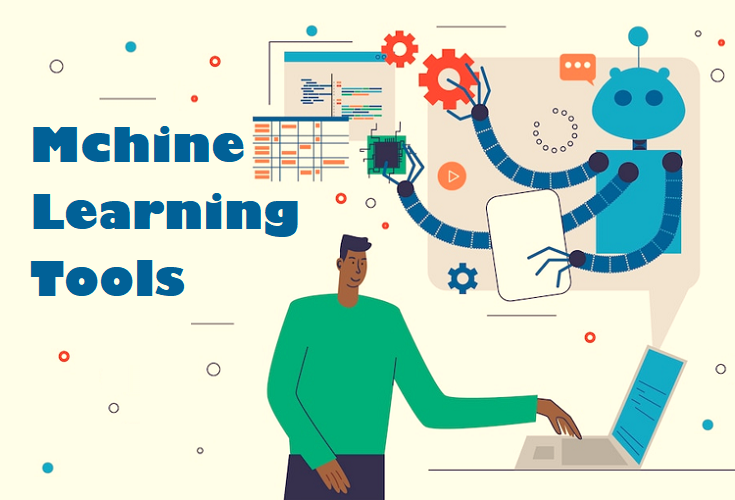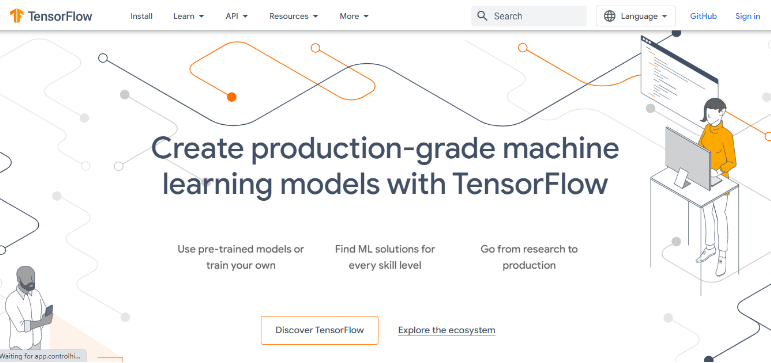In the present digital era, the capacity of computers to learn and make sensible decisions has revolutionized many sectors and changed how people live and work. Whether you’re a seasoned data scientist, an inquisitive newbie with a passion for machine learning, or just interested in this cutting-edge technology, this blog is your doorway to exploring the vast spectrum of machine learning tools available today.
The most recent frontier of artificial intelligence is represented by machine learning technologies, which allow computers to analyze enormous volumes of data, spot patterns, and come to remarkably accurate conclusions. These resources include a wide range of algorithms, frameworks, libraries, and software platforms that give users the means to create, train, and use machine learning models.
We’ll take you on a tour of the many machine-learning tools you may use in this blog. The benefits of machine learning tools will be discussed, along with their common traits, current trends, problems with AI and machine learning tools, and how to pick the best machine learning tools.

What are Machine Learning Tools?
Machine learning tools are characterized as artificial intelligence algorithmic programs that allow a system to perceive and evolve without being explicitly coded (e.g., Caffee 2, Scikit-learn, Keras, Tensorflow, etc.). These technologies are capable of doing complicated processing tasks, including speech-to-text transcription, natural language generation, picture awareness, etc.
What Do Machine Learning Tools Do?
Machine learning tools are designed to perform a range of tasks related to the development, deployment, and management of machine learning models. These tools provide functionalities such as data preprocessing, feature engineering, algorithm selection, and model training, enabling users to build accurate predictive models. They facilitate the exploration and analysis of data, allowing users to uncover patterns, relationships, and insights that inform decision-making.
Machine learning tools also offer capabilities for model evaluation, validation, and optimization, helping users assess the performance of their models and fine-tune them for better results. Additionally, these tools assist in model deployment by providing mechanisms to package and integrate models into production environments, allowing real-time predictions or decision-making.
Furthermore, machine learning tools often include features for model monitoring and management, allowing users to track model performance, detect drift or degradation, and initiate retraining processes as needed. They can also visualize model outputs, feature importance, and decision boundaries, aiding in model interpretation and communication of results.
Overall, machine learning tools streamline and automate various stages of the machine learning workflow, empowering users to leverage data-driven insights, make informed decisions, and create intelligent applications and systems across a wide range of domains and industries.
Types of Machine Learning Tools
Machine learning resources are powerful instruments that use various methods and data to automate and enhance activities. These technologies make it possible to create and use intelligent systems, giving firms the ability to gain useful information and boost productivity across a range of industries.
Supervised Learning
Supervised learning is a machine learning approach where the model learns from labeled data, making predictions based on input-output pairs. It involves training the model with known examples to generalize and make accurate predictions on unseen data.
Unsupervised Learning
Unsupervised learning focuses on finding patterns or structures in unlabeled data without explicit guidance. These algorithms aim to uncover hidden relationships, group similar data points, or detect anomalies, enabling valuable insights and discoveries in data analysis.
Reinforcement Learning
Reinforcement learning involves training an agent to make sequential decisions through interaction with an environment. The agent learns by receiving feedback in the form of rewards or punishments, adjusting its actions to maximize cumulative rewards, and achieving optimal decision-making in dynamic environments.
Deep Learning
Deep learning is a subset of machine learning that utilizes artificial neural networks with multiple layers to extract high-level features from raw data. It has revolutionized tasks such as image and speech recognition, natural language processing, and autonomous driving, enabling breakthroughs in various fields through its ability to learn complex patterns and representations.
Benefits of Machine Learning Tools
When it comes to advantages, machine learning can help enterprises understand their customers at a deeper level. By collecting customer data and correlating it, machine learning tools provide it all. The benefits of machine learning tools are:
Better Advertising and Marketing
With the use of machine learning techniques, organizations can make use of enormous volumes of data to learn about client behavior, preferences, and purchasing trends. Businesses may develop personalized suggestions, targeted advertising campaigns, and specialized marketing plans by analyzing this data, which leads to better consumer engagement and greater conversion rates.
Faster Decision-Making
Machine learning engineer tools offer automated decision-making and real-time information. These technologies help organizations make well-informed decisions quickly by analyzing huge datasets and spotting trends. As a result, decision-making processes are accelerated, operational efficiency is increased, and firms are better prepared to react rapidly to shifting market conditions.
Accurate Forecasting Demands
Tools in machine learning can more accurately forecast future demand by analyzing past data, market patterns, and external variables. Businesses may do this to streamline operations such as inventory management, production planning, and supply chain management, lowering costs and lowering the possibility of stockouts or overstocking.
Personalized Customer Engagement
Businesses may personalize client experiences by examining individual preferences, purchase histories, and browsing behavior using machine learning tools. These Tools used in machine learning make it possible to provide targeted suggestions, and special-order offers, and communicate in a way that is most appealing to each individual consumer.
Trend Management
Large datasets may be quickly and effectively analyzed using machine learning algorithms to find trends, patterns, and anomalies that people might not be able to recognize. Businesses may make data-driven choices, find unexplored possibilities, and gain a competitive advantage in the market by drawing out important insights from their data.
Common Features of Machine Learning Tools
Algorithm libraries and frameworks that offer ready-made algorithms and methods for analyzing information and training models are typical elements of machine learning tools. Let us now learn about the key features of machine learning tools:
Predictive Modeling
Best machine learning tools offer predictive modeling capabilities, allowing users to build models that can make accurate predictions or classifications based on input data. These models are trained on historical data and can be used to forecast future outcomes, identify patterns, or make data-driven decisions.
Automation
Machine learning tools automate various tasks involved in the machine learning workflow, such as data preprocessing, feature selection, model training, and evaluation. Automation streamlines the process, reduces manual effort, and enables users to focus on higher-level tasks, improving productivity and efficiency.
Data Preprocessing
Data preprocessing is a crucial step in top machine learning tools, and these tools provide functionalities to clean, transform, and normalize raw data. They handle missing values, handle outliers, perform feature scaling, and handle categorical variables, ensuring that the data is in a suitable format for model training and analysis.
Easy Deployment
Machine learning tools facilitate the deployment of trained models into production environments. They provide mechanisms to package models, integrate them into existing systems or applications, and expose them as APIs for real-time predictions or decision-making, making it easier to operationalize machine learning solutions.
Algorithm Selection
Machine learning tools offer a wide selection of algorithms and models to choose from, catering to various machine learning tasks and requirements. Users can select the most suitable algorithm based on the problem domain, data characteristics, and desired outcome, ensuring optimal model performance.
Model Visualization
Machine learning tools provide visualization capabilities to understand and interpret the trained models. They offer visual representations of model performance, feature importance, decision boundaries, and other insights, aiding in model evaluation, debugging, and communication of results to stakeholders.
Model Monitoring and Management
Machine learning tools enable the monitoring and management of deployed models. They provide functionalities to track model performance, detect drift or degradation in model accuracy over time, and trigger alerts or retraining processes when necessary. This ensures that models remain effective and up-to-date in dynamic environments.
How to Choose the Best Machine Learning Tool?
Several things need to be taken into account when choosing a machine-learning development tool. When selecting the finest tool to meet project needs and increase success possibilities, it is important to take into account elements like data quantity, accuracy, algorithms, scalability, and performance. Check out the methods for selecting the finest machine-learning tools.
Accuracy of the Output
It is important to determine the significance of precision and readability for the use case at hand. Find tools with strong model assessment metrics and explainability characteristics.
Algorithm Availability
Analyze the toolset’s capacity to support a wide variety of machine learning techniques. Look for platforms or libraries that provide well-liked algorithms and methods for various tasks.
Scalability and Performance
Examine the project’s performance and scalability requirements. To ensure successful processing and quicker outcomes, use tools that can handle large-scale calculations, parallel processing, and distributed systems.
Top 5 Machine Learning Tools
The top 5 machine learning tools are TensorFlow, Keras, PyTorch, Weka, and Knime. Here are the features, pros, and cons of the tools mentioned below:
1. TensorFlow

A free and open-source software library for artificial intelligence and machine learning is called TensorFlow. Although it may be used for many different tasks, deep neural network training and inference are given special attention.
Features
- TensorFlow allows for a clear graph visualization unlike Numpy or SciKit
- TensorFlow is highly robust and modular enabling standalone sections and flexibility
- TensorFlow supports pipelining for efficient training on large scale platforms
Pros
- Tensorflow is not constrained to a single type of gadget. It functions just as effectively on a mobile device as it does on any other sophisticated piece of equipment.
- Anyone who wants to use it can do so without paying anything. Any user can utilize this module whenever and wherever they need to due to this capability.
- Numerous neural network tasks, including time series analysis, NLP, and picture classification, are supported.
Cons
- The challenging learning curve, particularly for newcomers.
- Despite all of Tensorflow’s benefits, Windows users can only access a small portion of its functionalities. This isn’t the case with Linux users, who have access to a vast range of capabilities.
- In comparison, it is slower and less functional than rival frameworks.
Pricing: Starts from 0.025$ per hour.
2. Keras

An open-source, cost-free deep-learning library is called Keras. Google created the high-level Keras deep learning API to implement neural networks. It is used to make the implementation of neural networks simple and is developed in Python. Additionally, various backend neural network computations are supported.
Features
- Keras is an API-based tool that is way more Pythonic.
- Modularity is a significant feature of Keras.
- User experience and smooth production of deep learning models are its key priorities.
- Modeling and creating a deep neural network is easy yet robust.
- It supports rapid and easy prototyping of models.
- Keras is a high-level API that supports multi-platform and multi-backend integrations.
Pros
- A user-friendly API, Keras makes it simple to build neural network models. Natural language processing and deep learning techniques work well with it. In just a few lines of code, we can create a neural network model.
- The documentation for Keras is among the finest ever. You are given a well-organized and chronological introduction to each function through the documentation. The provided scripts and examples are quite helpful in understanding how the procedure behaves.
- Some deep learning models with pre-trained weights are offered by Keras. These models may be applied directly to feature extraction or prediction.
Cons
- There are various aspects of Keras that can be improved. Some pre-trained models are missing from it. Dynamic chart-generating functionalities are not supported by Keras.
- The Keras library’s error messages are ineffective. There is a need that the errors be clearly visible. Finding the error’s primary cause is not all that informative or helpful. Keras requires a lot of debugging.
- You frequently receive low-level errors from Keras. These low-level failures are a result of some operations and capabilities that Keras is unable to do. Additionally, Keras lacks the ability to do complex calculations.
Pricing
- It has no fixed cost. Under the MIT license, Keras is publicly accessible and may be used, modified, and distributed by anyone.
3. PyTorch

Python and the Torch library form the core of PyTorch, an open-source framework for machine learning (ML). Torch, which is a machine learning library built on Lua scripting language, PyTorch is widely known for its ability to construct powerful deep neural networks. Among the various platforms available for studying deep learning, PyTorch stands out as one of the most popular choices.
Features
- Dynamic computation graph that allows easy debugging and flexibility
- Strong support for deep learning techniques and neural networks
- Integration with popular Python libraries
- Efficient GPU acceleration
- Distributed training capabilities
Pros
- A Rich collection of APIs to extend the Pytorch Libraries
- Easy to use
- Easy and convenient debugging can be done using different Python IDEs
- Supports the cloud platform for model storage and execution
Cons
- Lack of consistent API for profiling and performing experiments
- No “good practices” for computing models
- Limited support for compiling models in a static graph for edge devices (e.g. via ONNX only)
Pricing
- Starts at $0.16$ per hour
4. Weka

For data mining jobs, Weka is a set of machine learning algorithms. It has tools for mining association rules, grouping, regression, classification, and visualization of data.
Features
- A comprehensive collection of machine learning algorithms for data preprocessing, classification, regression, clustering, and more.
- The graphical user interface for ease of use.
- Supports various data patterns and provides visualization tools.
- Feature selection and attribute evaluation techniques.
- Integration with other data mining tools.
Pros
- Testing new ideas efficiently
- Easy to adapt and resolve data mining problems
- You can try various algorithms on your data set to quickly see which gives you the most final and authentic results.
- It is self-reliant software that can run on most machines that run Java
Cons
- For large datasets, scalability is constrained.
- slower than some other tools, in comparison.
- For sophisticated customization, more programming could be needed.
Pricing
- Weka is open-source software issued under the GNU General Public License. For pricing, contact the vendor.
5. KNIME

KNIME, a visual workflow-based machine learning tool, offers both open-source and commercial editions. It’s data preparation tool enables anybody to comprehend data and create analytical workflows. It allows users to access a wide range of machine learning and data mining functionalities.
Features
- Scalability through sophisticated data handling (intelligent automatic caching of data in the background while maximizing throughput performance)
- High, simple extensibility via a well-defined API for plugin extensions
- Parallel accomplishment on multi-core systems
Pros
- It resolves the problems very quickly without using any codes. It just uses the drag-and-drop flow.
- Data Wrangling and manipulation functionalities are certainly sufficient.
- A clear view of the data at every step of the ETL process enables changing the flow as needed.
- Valuable attributes include visual workflow creation, workflow variables (parameterization), automatic caching of all intermediate data sets in the workflow, and scheduling with the server.
Cons
- The visualization functionalities are not good.
- The program is not fit for handling very large files or databases (greater than 1GB); it gets too slow and has a tendency to crash easily.
- Data field type conversion is a real struggle, and date fields are a hassle; documentation is pretty poor; and the user community is average at best.
Pricing
- It is freely available for use.
Challenges in AI and Machine Learning Tools
The necessity for high-quality and labeled data for training correct models, as well as the difficulty of choosing the right methods and parameters for a specific task, are challenges for AI and machine learning technological advances. Let’s examine the challenges in more depth.
Automation Pushback
One challenge with ai and machine learning tools is the pushback from individuals or organizations resistant to automation. This can arise from concerns about job displacement or a lack of trust in automated decision-making systems. Overcoming this challenge requires effective communication, education, and demonstrating the value and benefits of automation in enhancing efficiency and productivity.
Data Quality
The quality of the data used for training machine learning models greatly impacts their performance and reliability. Challenges in data quality include missing values, inconsistent or inaccurate data, and biased datasets. Addressing these challenges requires rigorous data preprocessing, thorough data validation, and the implementation of data quality assurance measures to ensure the integrity and reliability of the training data.
Implementation
Implementing AI and machine learning tools successfully can be challenging due to various factors. This includes integration with existing systems, infrastructure requirements, scalability considerations, and aligning the implementation with organizational goals and processes. Overcoming implementation challenges often involves careful planning, stakeholder engagement, and robust project management to ensure smooth integration and adoption of the tools.
Latest Trends in Machine Learning Tools
Machine learning tools are becoming more versatile. They are simplifying tasks like robotic process automation and boosting cyber security. Machine learning technology is embracing certain trends. Let’s explore the latest trends in machine learning.
Automated Machine Learning (AutoML)
Automated Machine Learning (AutoML) is a growing trend that aims to automate the process of developing machine learning models. AutoML tools automate tasks such as data preprocessing, feature engineering, algorithm selection, and hyperparameter tuning, making machine learning more accessible to non-experts and accelerating the model development process.
Robotic Process Automation (RPA)
Robotic Process Automation (RPA) combines machine learning and automation to automate repetitive and rule-based tasks typically performed by humans. RPA tools use machine learning algorithms to mimic human actions and perform tasks such as data entry, data extraction, and process automation. This trend is revolutionizing industries by increasing efficiency, reducing errors, and freeing up human resources for more complex tasks.
No-code Machine Learning and Artificial Intelligence
No-code Machine learning and artificial intelligence platforms enable users without coding expertise to build and deploy machine learning models. These tools provide intuitive interfaces, drag-and-drop functionalities, and pre-built components that allow users to create and customize models without writing code. This trend democratizes machine learning, empowering individuals from diverse backgrounds to leverage the power of AI.
Conclusion
In conclusion, machine learning technologies have transformed a variety of sectors and professions by allowing data-driven decision-making, improving efficiency, and revealing insightful information. Choosing the best machine learning tool requires considering factors such as features, pricing, customization options, and integration capabilities. The power of the most popular machine learning tools is beneficial for researchers, financial institutions, data scientists, software developers & business analysts.
FAQs:
- How much do machine learning tools cost?
Several variables, including the particular tool or platform, the intended use case, the size of the deployment, and the vendor or provider providing the tool, can have a substantial impact on the cost of machine learning technologies.
- Which programming languages do machine learning tools support?
Python, R, Java, and C++ are just a few of the programming languages that are frequently supported by machine learning technologies. Due to its wide ecosystem and packages like TensorFlow and scikit-learn, Python is especially well-liked.
- How do machine learning tools assist with model evaluation?
Machine learning systems include measures like accuracy, precision, recall, and F1 score that help in model evaluation. Additionally, they include visualization tools for ROC curves, confusion matrices, and performance analysis.



